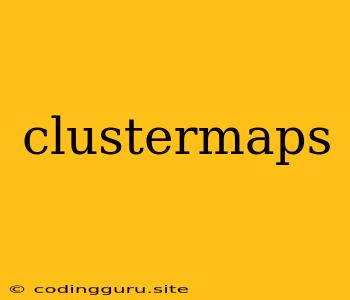Dive into the World of Clustermaps: A Comprehensive Guide
Ever felt overwhelmed by the sheer number of markers on a map? Imagine navigating a city map teeming with restaurants, or trying to decipher a world map dotted with every historical landmark imaginable. This is where clustermaps come to the rescue.
Clustermaps, as the name suggests, are maps that cleverly group or cluster similar markers together. Instead of displaying every single data point individually, clustermaps provide a more manageable and visually appealing representation of the data. This approach is particularly useful when dealing with large datasets where displaying every individual point would lead to clutter and confusion.
How do clustermaps work?
The magic of clustermaps lies in their ability to automatically group nearby markers into clusters. Each cluster is then represented by a single symbol, usually a circle or a square, whose size reflects the number of markers within that cluster. As you zoom in on the map, these clusters gradually disaggregate, revealing the individual markers within.
What are the benefits of using clustermaps?
-
Improved Clarity and Readability: Clustermaps make it easier to understand spatial patterns and identify areas with high concentrations of data points. They reduce visual clutter and improve the overall readability of the map.
-
Enhanced Data Visualization: Clustermaps provide a more efficient way to visualize large datasets. By grouping markers, they enable users to quickly grasp the overall distribution of data points.
-
Interactive Exploration: Clustermaps are often interactive, allowing users to zoom in and out to explore different levels of detail. Clicking on a cluster reveals the individual markers within, providing access to more specific information.
Where can you find clustermaps?
Clustermaps are widely used in various fields and applications, including:
- Geographic Information Systems (GIS): Clustermaps are a staple in GIS applications for visualizing population density, crime rates, or the distribution of natural resources.
- Business Analytics: Clustermaps help businesses understand customer demographics, identify high-traffic areas, or analyze sales data.
- Social Media: Clustermaps can be used to visualize location-based social media data, showing the concentration of users in specific areas.
- Web Mapping Platforms: Popular web mapping platforms like Google Maps and Leaflet offer built-in functionalities for creating clustermaps.
How to Create Your Own Clustermap
Creating a clustermap is relatively straightforward, especially with the help of readily available libraries and tools.
- Data Preparation: Ensure your data contains the necessary geographical information, such as latitude and longitude coordinates.
- Choose a Mapping Library: Libraries like Leaflet, D3.js, or Mapbox GL JS offer powerful tools for creating interactive maps.
- Implement Clustering Algorithm: Many libraries provide clustering algorithms that automatically group nearby markers. Popular options include Leaflet.markercluster and the Mapbox GL JS clustering features.
- Customize Appearance: Style your clusters with different colors, shapes, and sizes to enhance visual appeal and data communication.
Examples of Clustermaps in Action:
- Real Estate: A clustermap can show the concentration of real estate listings in a city, allowing potential buyers to quickly identify neighborhoods with high inventory.
- Traffic Analysis: Clustermaps can depict the location of traffic accidents or congestion points, aiding in the development of traffic management strategies.
- Healthcare: Clustermaps can visualize the distribution of hospitals and clinics, helping people quickly find healthcare facilities in their vicinity.
Conclusion:
Clustermaps are a powerful tool for simplifying complex data and enhancing visual clarity. By grouping markers together, they offer a more manageable and insightful way to visualize spatial patterns. Whether you're exploring city maps, analyzing social media data, or uncovering trends in business analytics, clustermaps provide a valuable aid in making data more understandable and actionable.
